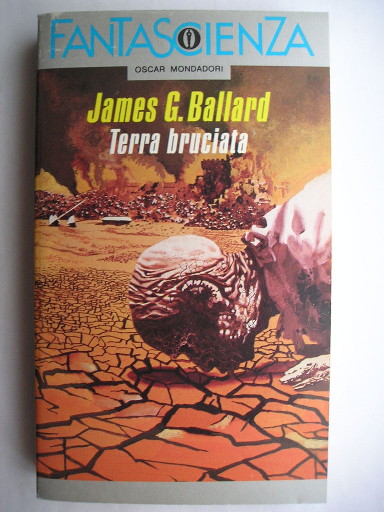
The novel “The Burning World” by J.G. Ballard was published for the first time in 1964 and republished in 1965 in an extended version under the title “The Drought”.
Dr. Charles Ransom’s life has had a number of complications with the end of his marriage and the first consequences of a prolonged drought. Fresh water is becoming increasingly scarce, but Ransom hopes to keep on having enough by living on a boat on a lake. Unfortunately, the river that feeds the lake is thinning.
Over time, the drought worsens. The cause has been discovered, but no one can find a solution. More and more people are moving to the coasts, even knowing that desalinating seawater to quench the thirst of a large population is a huge undertaking. The relationship between Ransom and the people who live near the lake isn’t always easy, and over time it gets worse because a new superstition makes people see him as a bringer of death.
In “The Drought” the cause of the catastrophe is industrial pollution. The chemicals thrown into the seas ended up forming a polymer on their surface that almost completely prevents the water from evaporating. The result is the progressive disappearance of the clouds and consequently of rainfall. It’s an explanation that is useful to understand the origin of the drought, the reason why it continues, and the difficulties in finding a solution. However, J.G. Ballard is especially interested in telling people’s reactions to an increasingly difficult situation in which humanity remains essentially defenseless in the face of the consequences of the damage it caused.
The protagonist Charles Ransom is a doctor, a recurring feature in J.G. Ballard’s works, but his profession is mostly a burden in the novel. In particular, over time he starts being considered a bringer of death by superstitious people after losing several patients in the early years of the drought. His attitude is complex, at times even contradictory as at times he’d like to be left alone but then he doesn’t want people to stay away from him. His diverse impulses lead him to try to help others, but also to feel more and more detached. All this ends up making him almost an external witness of the progressive collapse of the society that occurs with the shortage of fresh water.
The attention to the psychological side in the characters’ reactions is one of the typical elements of J.G. Ballard. In “The Drought”, fresh water becomes increasingly scarce, and for this reason more and more precious. Interpersonal relationships become difficult because finding fresh water becomes a priority that divides people instead of uniting them in difficulty. The consequence is that one’s neighbor becomes a competitor in the use of increasingly scarce reserves. The growing aridity of the territory is mirrored in human beings’ aridity.
The territory is in a way a character itself because J.G. Ballard offers various descriptions of increasingly arid landscapes, often in relation to the water still present or the traces it left. The author also drew inspiration from painting, and was particularly influenced by surrealism. The result is that his descriptions can be very vivid and suitable for catastrophic stories that also generate alienation among human beings.
“The Drought” has become a classic with a fame that went beyond the limits of science fiction or the catastrophic genre. Thinking of the growing territories that have recently been facing prolonged droughts, in my opinion it’s a novel that has become even more significant today.

